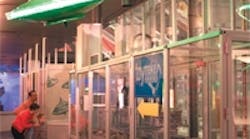How do you get kids excited about manufacturing? Have them make their own toy, of course. At least, that is the motivation behind a new exhibit at Chicago’s Museum of Science and Industry.
Called ToyMaker 3000, the exhibit features a 2,000-ft automated assembly line where 12 robotic arms work together to crank out more than 300 toy tops in one hour. Visitors follow the tops through a CIM process from gathering parts to assembling them.
“Our goal from the beginning was to create an exhibit that would capture the imagination of young people and encourage them to learn more about jobs in manufacturing,” says John Meyer, museum exhibits project manager. “We want kids to step into our toy top factory and see the feeder systems, robotic arms, ultrasonic welders, and conveyor belts and think manufacturing is cool.”
To get the CIM line up and running, Rockwell Automation, Milwaukee, donated $1.5 million worth of motors, gear reducers, computer displays, and software. Surrounding the assembly line are interactive exhibits, robotic games, computer-aided-design stations, and multi-media displays that help guests learn about the diverse jobs in the automated manufacturing industry. Rockwell employees talk via a video monitor about what it is like to solve engineering problems and design products.
For a small fee, visitors can customize a top to take home. After choosing a color and personalizing the toy with their name, visitors follow the CIM line and watch as their toy is assembled. The process ends with a robot delivering the packaged toy top and waving goodbye. Tops not custom made are disassembled and robotically dumped into appropriate storage bins, ready to be reassembled another day. The nonstop process takes less than five minutes from start to finish.
Bearing and gear make gust-boosting team
An integrated flexpin bearing from The Timken Co., Canton, Ohio, is helping to boost wind turbine performance for MAAG Gear AG. The Swiss firm is using the bearing for one of its giant wind turbine transmissions, which will be part of a new Nordex turbine design.
The tapered rolling bearing evenly distributes torque to multiple planetary gears, resulting in long gear and bearing life. It consists of only five components, compared with conventional planetary bearing assemblies that typically have as many as 10. A preset bearing clearance shortens assembly time. In addition, the new design can upgrade existing wind turbines.
Setting a new standard
The National Electrical Manufacturers Association has released a revised standard on motors and generators. MG 1-2003, a revised version of MG 1-1998, provides more than 500 pages of manufacturing and performance data related to electric motors and generators designed to help users with selection and application.
The new version includes a section on NEMA Premium efficiency motors, with information on short-timerated machines and modifications in dimension tables and drawings. Additionally, Part 5, “Classification of Degrees of Protection Provided by Enclosures for Rotating Machines,” has been updated to align MG 1 with the IEC 60034-5 standard.
Purchase MG 1-2003 by visiting www.nema.org/r/std/mg1/ or calling Global Engineering Documents at (800) 854-7179.
Servodrives make an impression
Cincinnati-based Roto Press International, now Nilpeter USA, specializes in flexographic presses for the tag, label, and converting industries. Its eight-color Model 8518 Servoflex flexographic printing press runs at speeds of 750 to 1,000 fpm. It’s equipped with combination hot air and ultraviolet drying and features 50-in. unwind and rewinds.
When designing its first completely servodriven press, Nilpeter selected Bosch Rexroth’s servodrive system, which lets users run a variety of substrates from 0.001-in. film, such as the material used for soda bottle labels, to 0.02-in. carton stock, a thinner version of the material used for cereal boxes.
A big benefit of the servodrive package was the high level of control and ease of use the programming software provided. One program features Windows-based, point-and-click selection of preconfigured algorithms, as opposed to other servodrive systems that need multiple software packages and require users to program their own algorithms.
Continue on page 2
The servodrive system cut time to market and decreased Nilpeter’s inventory, while providing its customers with higher print quality and greater flexibility. In addition, the fiber-optic network linking the servodrives in the Servoflex is immune to noise and has shown no signs of noise interference since Nilpeter began employing it.
A zap trap
If what they say about building a better mousetrap is true, Woodstream Corp. had better be ready for the masses to knock at its door. The Lititz, Pa., company’s new Victor EMT is the first mousetrap to use electronics for a fast, clean catch and easy disposal.
A patented tunnel design guides and positions the mouse for capture with no possibility of escape. A demise of five to 10 sec makes the EMT a humane trapping alternative. Once a mouse is caught, a signal light blinks green for 24 hr to alert users.
Several built-in safety features eliminate the risk of shock when handling the unit. Tunnel diverters physically prevent anyone from contacting the plates when the EMT is set. While the tunnel lid is opened, the EMT automatically disarms, so users can bait or dispose of a mouse. It rearms when the lid is closed.
U.S. packaging still in the lead
U.S. packaging machinery manufacturers maintained their lead in the marketplace in 2002 by shipping an estimated $5.851 billion in packaging equipment, up $26 million from 2001. The figures come from the Confederation of Packaging Machinery Associations (COPOMA), a collaborative market research effort of the world’s 13 largest packaging machinery associations.
COPAMA reports shipment of packaging machinery reached $21.206 billion in 2002, a $1.343 billion increase over 2001. The 6% rise in packaging machinery purchasing represents the tabulation of 11 of COPOMA member companies, and includes the first report of Russia’s figures.
German manufacturers came in second with $3.762 billion sold, moving up one spot from the 2001. Japan moved down one, with $3.168 billion in sales.




